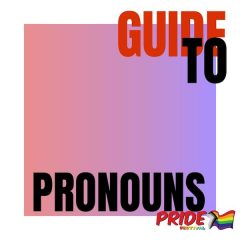 What are Pronouns?
What are Pronouns?
Pronouns are used in place of a proper noun (like someone’s name). Most often, pronouns are used then referring to someone without using their name.
Example: Have you heard from Jamie? She hasn’t texted me back all day. She is the pronoun.
–
Why is it Important to use the Right Pronouns?
Like someone’s name, pronouns are often a part of someone’s identity. In English and many other languages, pronouns specifically refer to a gender (e.g. she/her/hers and he/him/his). Therefore, when someone is referred to with the wrong pronoun, it can often lead to them feeling disrespected, invalidated, dysphoric, or alienated. An important thing to note is that pronouns do not have to correspond with a person’s gender expression.
How do I Use the Right Pronouns?
The best way to use the right pronouns is to ask them! An easy way to do this is by volunteering your pronouns during your introduction or at the start of the conversation, often the other person will volunteer theirs. Don’t pressure others into sharing their pronouns as some people may not feel comfortable doing so.
What if I Use the Wrong Pronouns?
Mistakes happen – simply apologize, correct yourself and move on! The best thing that you can do is to use the correct pronouns the next time. If you’re struggling to get used to using the correct pronouns or integrating them in proper sentence structure, check out the resources on the last slide and try the ‘pronoun practice’ website.
Examples of Common Pronouns
| Pronoun | Sounds like | Variations |
| He/Him | You already know this one! | His, Himself |
| She/Her | You already know this one! | Hers, Herself |
| They/Them | Yes, it’s okay to use this when referring to a singular person! | Theirs, themself |
| Ze (or Zie) | Zee (like “see” with a “Z”). | Can also be spelled as xe |
| Name | Whatever their name is! | Some people don’t want to use pronouns at all and will ask you to refer to them by their name alone. |
